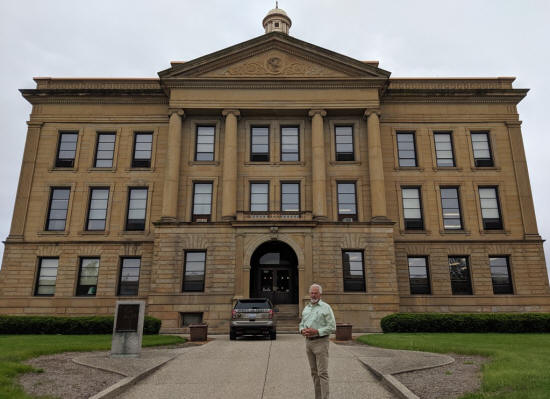|
Building restoration specialist to
assess Logan County Courthouse
 Send a link to a friend
Send a link to a friend
 [May 23, 2019] [May 23, 2019]
At the Logan County Board meeting on Tuesday, May 21st, the board
voted on whether to move forward with having Bill Walter of Lima,
Ohio, begin looking into what is needed to restore the courthouse.
Walter’s proposal totaled $99,885 to be completed in three phases.
Walter is giving the county a $5,550 discount since the actual total
for the three phases is $105,435.
At the special meeting held Monday, May 13th, board members and
several county employees heard from Walter, a building restoration
specialist who owns Masonry Restoration Technologies and Services.
Like his father before him, Walter has been in the restoration
business for many years and enjoys getting buildings back to what
they once were. He has worked nationwide and projects have included
the Indiana State Capitol Building, Ellis Island, The Federal
Reserve Bank, and the Hancock Building, Providence Hospital and the
Wrigley Building, in addition to four courthouse projects in the
last two years.
Walter holds numerous professional affiliations, extensive education
and certifications, and is part of President’s Advisory Council on
Masonry Restoration.

Building and Grounds Chairman Dave Blankenship contacted Walter
about “a unique courthouse with minor, major and perplexing issues”
and they discussed what it would take to put the courthouse back in
serviceable condition.
Last week, Walter took a tour of both the inside and outside of the
courthouse and went up to the dome area to get an idea of the
problems. He said the structure of the dome has great bones. He also
looked at the steps, sandstone and windows to get an idea of what is
needed.
Having worked on several other courthouse projects, Walter said he
looks at each project from a different vantage point and remembers
when everyone associated with a project was on a team with the goal
to get the project done. Now it seems to be opposing sides at times
with good news and bad news.
This project reminds Walter of the fun and satisfaction of projects
from different times. He said the courthouse is something with
“phenomenal potential” and the interior is outstanding because you
can stand in the rotunda and look everywhere or speak and hear the
echo from the dome.
Tuesday, there was more discussion and questions about the project
and its costs.
Board member Scott Schaffenacker asked about the project management
costs, which will depend on the ultimate size of the project, but
will range between two-and-a-half and five percent of the total
costs of the project. Schaffenacker said “For argument’s sake, let’s
pick $5 million at five percent and $2.5 M at two-and-a-half
percent. That is a range of a quarter million dollars to $62,500.”
He said it is hard to budget for the amounts.
Walter said there is a “sliding scale” and the range will depend on
the scope of work chosen to be done since some of it requires higher
level involvement. He makes a higher percentage the lower the amount
is, and the higher amount means a lower percentage for him.
Walter can multitask and fees would be less if work is done in less
time. He has work structured to accomplish the maximum for the same
amount of money.

Walter said more needs to be ascertained about what needs to be done
and the board can negotiate, decide what to do and be on the low
side percentagewise. What the board is now abiding by is the initial
outlay and Walter said the fee for project construction management
can be decided later.
In the first phase, Walter would be doing a thorough site
investigation, which would include reviewing the condition of the
dome, exterior sandstone façade, windows, doors, entrance steps,
basement and the courthouse’s current energy system. There would
also be inspection of the concrete and mold testing, and any
remediation planning needed.
Phase two would include roof inspection and consultation, HVAC
inspection and consultation, scaffold consultation, interior spaces
architectural work, and group coordination and planning.
Phase three includes specification and bid document preparation,
pre- and post-bid dates and management and project management.
Since Walter may unveil other problems and issues as he looks
further, he said some costs can be decided then.
The time frame for the project depends on how much restoration is
approved since there are several issues. Walter said it could take
eighteen months or longer and weather will be a factor.
Board member Chuck Ruben asked about outside funding sources. In the
proposal Ruben said he saw no experts listed in looking for funding
from the federal government and asked about whether the county
should find someone who can find funding.
The proposal is tailored around energy savings and HVAC, and Walter
said he would collaborate with an energy group to figure out needs.
There is a staggering list to investigate of what is available for
funding. And Walter said every time he has worked on these projects,
he has been successful in finding entitlements, grants, tax credits
or low interest loans. The government allows funding to help with
energy efficiency credits, but he would explore everything available
that appeals to people.

Walter can find out needs and rewrite that section of the proposal
to find out financing available.
In his courthouse project in Sydney County Ohio, Walter said they
got a low one-and-a-half percent interest loan to cover the balance
of the total project costs after energy credits and entitlements
from the state covered about 35 percent. That project costs $2.3 M
and Walter said they probably got $600,000 in tax credits and
entitlements.
Walter said some funding is tailored around energy savings. A
company would look at energy losses. The Energy Systems Group would
work with Walter to help “determine the very best and optimal
heating and cooling systems for this particular structure.”
Ruben said another company had already looked at energy losses, but
looked at one building and found the savings to pay for it were not
there.
Blankenship said he has not seen any projections or reports with
regard to the savings. Though told they had the most energy
efficient air conditioning system, Blankenship said he disagreed
with those findings. He has seen structures like the courthouse and
said across the industry, it is not unusual to experience 30 to 60
percent (energy) savings with the right system.
Walter said the average savings are about 40 percent.
As far as getting a loan, Ruben said a low interest loan would not
help when the county has no extra money in the budget. They took a
$600,000 loan for the major criminal case bond, and that is roughly
$50,000 a year. Another bond is $48,000 a year and the county is
barely able to maintain these bonds.
[to top of second column] |


Blankenship said he understands the tight financing, but can the county afford
not to do something? He is concerned over whether the board wants the courthouse
to continue deteriorating and asked about other counties with equal or worse
finance issues.
Board member Bob Sanders said doing everything basic is what got the courthouse
in this mess and we cannot let it go any longer because it could cause more
problems. Though he understands the money issues, Sanders said it would cost
more in the long run if not fixed. Water leaking on breaker boxes and people’s
safety is at stake, so there is a need to get work done as soon as we can.
Walter said other counties have found they are too poor to be cheap. They kick
the can trying to accomplish things in a hurry and if you consider all the money
they spent doing that, they would probably have a “formidable amount” to do the
project correctly. If doing work, Walter would do it right, not looking back
later and his approach would be encompassing.
There are still some “dramatic unknowns” as far as the dome and concrete
flooring, and Walter said once they have been quantified and qualified, he will
know costs. The costs may be high, but Walter cannot get money without providing
answers. The county can get money just for replacing the windows and Walter will
know more when he discovers what will be needed window wise from an energy
savings standpoint.
Board chairman Emily Davenport asked about why the windows in the courthouse
that were replaced about seven years ago may need to be fixed or replaced.
Windows may meet minimum energy standards, but Blankenship said they are not
foam injected or well-insulated. Derrick Haynes, who does courthouse
maintenance, said a few windows are leaking water, other windows are broken and
most need to be duct taped to keep heat in.

From a structural standpoint, Walter said the windows were good at the time they
were put in, but to be considered for tax credits and entitlements, windows must
“meet certain disparity parameters” between the energy expended now and the
energy you are going to save. Walter said the windows at this point are like a
screen door on a submarine. To replace them is not a deal breaker cost-wise
since it would net energy savings results that would help qualify the county for
tax credits.
Though the windows are not that old or bad, Walter said they could be better
from an energy efficiency standpoint of insulation, airtightness and water
tightness. If significant energy loss is discovered, he would track and find
what is lost and how thermal efficiency would make it better.
Regarding energy efficiency, Blankenship said it is wise to stay with current
energy standards and utilize some of the best products and technology. He said
specialists help avoid pitfalls.
Walter said if you install a system with the ability for interchangeable
components, these systems can be modified later by just interchanging a few
components when technology changes. Energy experts can help figure out what to
do and look ahead months and years.
Some have suggested using a singular energy system, but Blankenship said with
such systems, if one part goes down, the whole facility is down. He supports the
use of multiple systems to achieve maximum efficiency because other parts of the
system can pick up the slack if one goes down.
In considering who would do the construction, Schaffenacker asked whether Walter
used the same or different contractors for the three other courthouse projects.
Different contractors were used for each project, and Walter said he tries to
use local contractors when possible. He hired local contractors for the project
in Sydney County, Ohio. Walter’s goal is to incorporate local talent and he can
recommend contractors, but the board would help decide who to hire.
Davenport asked whether they can just pay for phase one at this point and Walter
said phase one would get the board further knowledge-wise.

Sanders said we do not need to cut corners but need to make an informed decision
and Walter is an expert in the field.
Board member David Hepler agreed with Sanders and said going with Walter would
likely be a good investment since he has a good reputation and his studies could
help the county qualify for some funding.
Without being able to provide answers, Walter said he has never been able to get
money, so he wants to be able to show what the money is needed for. Walter’s
goal is to have the building outlast all of us and he wants to see phase one
meet everyone’s approval so he can move on to phase two and phase three.
There is a cost savings in doing all three phases if that is the direction the
board wants to go, but Ruben said the next step of funding would be a problem.
He is not sure where the money would come from, but Ruben said some could be
taken out of the criminal cases and courthouse park and maintenance fund.
The state of Illinois is working on supplying all county and local governments
with a substantial amount of money for fixing up their buildings, which Walter
said could be a major contributor for this project. Until they find out what
they need to ask for, Walter said some amounts are not known. He would rewrite
one segment of the proposal to clarify what means and finances may be available.
Board member Jim Wessbecher asked about where the money from the state is coming
from.
Brenda Clark, one of the board’s administrative assistants said Governor
Pritzker’s budget and the Capitol Bill allows for both state and county
buildings to be renovated.
The Capitol Bill has been out there for a while, but Ruben said specific money
needs to go in for counties, but the flow has not been toward counties.
Contacting state representatives could help.
If a referendum goes on the ballot again, Sanders said the information Walter
brings forward would help make the public a lot more informed.
Wessbecher asked how the board should proceed since they are not informed about
what is needed yet.

Blankenship asked Walter if he would add information about funding sources to
his proposal to help.
After the discussion, the board unanimously approved Blankenship’s motion to
move forward on working with Bill Walter.
[Angela Reiners] |